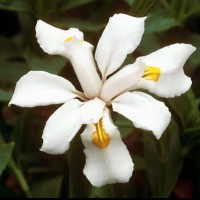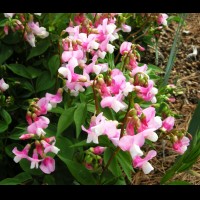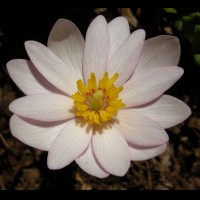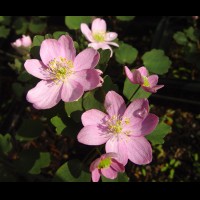Epimedium brachyrrhizum
Epimedium brachyrrhizum (Several clones/Cc. numbers)
Discovered in 1994 in Guizhou Province, China, it is one of the shortest species at only 6-8" tall, and among the largest flowered and earliest to bloom, with lavender-pink flowers nearly 2" across! New leaflets may be handsomely mottled with red-maroon in spring. Dark evergreen leaflets have a distinct corrugated surface, and many clones take on maroon overtones in fall. Not available this year.
Epimedium brachyrrhizum 'Karen'
Epimedium brachyrrhizum ‘Karen’ (Cc. 940526)
After years of trialing this plant against other superior forms of E. brachyrrhizum this stands out as the best for its prolific, large flowers in a soft shade of lavender-pink, combined with large leaves, heavily mottled with deep cranberry-rose in the spring. E. brachyrrhizum just happens to be one of my favorite Epimediums, so Darrell named this outstanding clone in my honor. 7” tall. Evergreen.
Epimedium brevicornu
Epimedium brevicornu (Several clones/Cc. numbers)
A beautiful hardy, deciduous species native to the northern regions in China where Epimediums are not normally found. These are divisions from plants collected during Darrell’s 2001 expedition to Henan Province where no Epimediums had been previously recorded. Produces an 8 to 10” high mass of small, rather round, heart-shaped leaflets. Numerous 10” long spikes carry “clouds” of small, star-shaped white flowers, each with short, reflexed spurs with a hint of yellow in the center. New leaflets may be speckled with reddish-purple and are thin and reminiscent of parchment paper to the touch. Hardy to Zone 4 and perhaps even 3! Early and long blooming, sometime for up to a month! $22
Epimedium grandiflorum 'Dark Beauty'
E. grandiflorum ‘Dark Beauty’ (Cc. 950132)
Harold Epstein admired this plant for its velvety, deep chocolate-purple new spring foliage. It appeared as a seedling in his garden from an apparent cross between ‘Yubae’ and ‘Silver Queen’. Its large flowers have beautiful dark rose inner-sepals and white petals/spurs flushed with rose. Small leaflets. 8” in bloom with second flush to 12”. A strong grower and one of the first “Eps” to emerge and bloom each year in the nursery.
Epimedium grandiflorum 'Queen Esta'
E. grandiflorum ‘Queen Esta’ (Cc. 920021)
A beautiful cultivar named by Harold Epstein after his wife, Esta. It was the first named seedling ever introduced from his garden. Notable for its large flowers with dark lavender inner-sepals and pale lavender spurs held against the chocolate-brown new spring foliage. It grows 6-8” tall in bloom, with a second flush of new dark leaves to 12”. Small leaflets. One of the earliest E. grandiflorums to bloom in spring.
Epimedium grandiflorum 'Silver Queen'
E. grandiflorum ‘Silver Queen’ (Cc. 900003)
Very textural with leaves usually divided into 27 small leaflets that are mahogany-flushed in spring. The large white flowers have "silvery-lavender" highlights on the inner-sepals. 7" tall in bloom, second flush to 11". A parent of many cultivars. An early bloomer.
Epimedium grandiflorum var. violaceum
E. grandiflorum var. violaceum (Cc. 890001)
Exquisite deep chocolate, small, spring leaflets form a lovely background for the bright, medium- lavender flowers. One of the very earliest Epimediums to emerge and bloom in the nursery. Makes a clump 8-10” in bloom, with a second growth flush to 12”.
Epimedium grandiflorum var. violaceum 'Bronze Maiden'
E. grandiflorum var. violaceum ‘Bronze Maiden’ (Cc. 920016)
***1999 Cobblewood Introduction***
Spring leaflets emerge a glossy mahogany-red, resembling molten chocolate. This intense color complements the medium-sized lavender flowers. 8” in bloom, with a second growth flush to 12”. One of the earliest epimediums to bloom. Semi-evergreen.
Epimedium sempervirens
Epimedium sempervirens Cc. 950031
Medium-sized, crisp, white flowers bloom above long tapered leaflets. One of the earliest epimediums to bloom in spring. Foliage makes an 8” mound. Spring leaflets are touched with a band of red around their edge. A bright little harbinger of spring. Semi-evergreen.
Epimedium sempervirens 'Passion Hearts'
Epimedium sempervirens ‘Passion Hearts’ (Cc. 180040)
***2019 Cobblewood Introduction***
A great, new introduction from Massachusetts hybridizer Mark McDonough. Spring foliage emerges a deep chocolate brown and warms up as spring progresses, through a kaleidoscope of vibrant red tones. Eventually the color fades to the edges before greening up in a tidy mound of elongated, heart-shaped leaflets. Generous clusters of medium-sized flowers with light lavender sepals and a lighter cup dot the low mound of colorful spring foliage. Semi-evergreen.
Epimedium sempervirens 'Snowshoe Lake'
Epimedium sempervirens ‘Snowshoe Lake’ (Cc. 920033)
***2014 Cobblewood Introduction***
A white flowered very floriferous form of this extremely early bloomer. Sited in bright shade or a couple of hours of sun a day, it will produce clouds of clean white medium-sized flowers, 6” above the ground at the first thaw. Leaflets sport a delicate red line along their margins in early spring.
A cheerful and fitting tribute to my late brother George who lived on Snowshoe Lake in Alaska. 8-10” at maturity. An early bloomer.
Epimedium stellulatum "Narrow Leaf Forms"
Epimedium stellulatum “Narrow Leaf Forms” (Sev. clones/Cc. #)
NACPEC (North American China Plant Exploration Consortium), is a group of ten botanic gardens and arboreta from across the U.S. and Canada, organized by the National Arboretum to explore areas of China on an annual or semi-annual basis. NACPEC has made several exciting discoveries, including this group of Epimedium stellulatum.
Discovered in several areas in the Qin Ling Shan of Shaanxi Province in 1996, the evergreen leaflets are medium in size, narrower than the original form and have especially spiny margins. 12-18”. The flowers are small white “stars” with tiny yellow petals on long, erect stems held well above the leaves. The floral display is like a miniature constellation suspended above spiny evergreen foliage. Early flowering and long-blooming, 12-18” tall. Hardy to Zone 4, possibly 3.
Epimedium sutchuenense
Epimedium sutchuenense (Several clones/Cc. Numbers)
This new Chinese species is from the mountains of southern Shaanxi and northwest Hubei Provinces where it blankets the slopes at approximately 6,000’ elevation. Superficially it resembles E. leptorrhizum, with large, lavender-mauve flowers. Spreads by long, thin 8-12" rhizomes. It produces two leaves on every flower stem, each with three medium-sized, smooth-faced leaflets. Uniformly short at less than 4” tall, it makes an excellent, low, evergreen ground cover.
Epimedium 'Short Story'
Epimedium ‘Short Story’ (Cc. 170040)
***2019 Cobblewood Introduction***
A showy, robust, new hybrid from Massachusetts breeder Mark McDonough. This unique selection combines the best of evergreen E. brachyrrhizum and deciduous E. grandiflorum. Spring emergence starts with an upright filigree of bronze stems and small leaflets, giving high visibility to luscious clusters of large silvery pink flowers with conspicuously down-turned spurs. As the leaves expand they are mottled in soft red. The flowers are held high and more prominently than in brachyrrhizum, for a fine display. The second flush of semi-evergreen foliage is just as dramatic as the plant is in bloom, boldly marked with bright red over chartreuse green.
Iris cristata 'Montrose White'
Iris cristata ‘Montrose White’
***2010 Joe Pye Weed's Garden Introduction***
A showy, strong-growing, clean white form, originally from Nancy Goodwin at Montrose Nursery. Its large, nearly 3” diameter flowers are unique among the “albas”. Grows to 6” tall. Spreads 2-4" per year. (Photo courtesy of Jan Sacks)
Iris odaesanensis
Iris odaesanensis
Pristine white flowers with a yellow signal edged in a thin, brown halo. Two flowers, each nearly 2” in diameter, are borne atop 8” stems in late May. Semi-evergreen leaves expand after bloom to reach 12” long, 1/2” wide, forming dense clumps of arching foliage. Prefers a little more sun than Epimediums. This clone was originally collected on Odaesan in Korea by Darrell Probst in 1997.
Iris odaesanensis Chuwangsan #3
Iris odaesanensis “Chuwangsan #3”
I. odaesanensis was previously known to exist only on the top of Odae-san (san = mountain). To the surprise of his Korean host from Chollipo Arboretum, Darrell found a few pockets of it growing on a wooded rocky ledge on Chuwangsan, 100 miles south of Odaesan. He collected three unique clones.
The flowers of this vigorous grower lack the typical brown halo surrounding the signal. It also seems to be less tasty to the local slugs. Semi-evergreen.
Jeffersonia dubia "Dark Centers"
Jeffersonia dubia “Dark Centers”
Name change to: Plagiorhegma dubia "Dark Centers", but I can't bring myself to call it that.
This plant provides a pop of welcome early spring color as soon as the ground thaws. New leaflets emerge a rusty brown color to contrast with the periwinkle blue/lavender petals. A cranberry colored ovary and dark purple/black anthers add to its charm. These plants are seedlings from plants Darrell collected in the wild in Korea.
Lathyrus vernus 'Albo-roseus'
Lathyrus vernus ‘Albo-roseus’
Another tough, long-lived perennial native to Europe for either full sun or partial shade. It tolerates many situations and is a good foliage plant throughout the season. Showy racemes of bi-colored pink and white pea-like flowers in earliest spring, on neat clumps to 18”. Leaves pinnately compound. Easy to grow and long-lived. (Photo by Jan Sacks)
Sanguinaria canadensis 'Venus'
Sanguinaria canadensis 'Venus' formerly “Pink Form”
In earliest spring, the buds of this native shade-loving Bloodroot variant emerge a deep pink. The showy wide-petaled flowers open light pink, and fade to shell pink. Dark pink stems on both leaves and flowers. The reverse sides of the petals remain a darker pink, repeatedly displaying their rich pink blush when they close each evening. Gradually spreads by thick fleshy rhizomes, 2-6" per year, to form a large colony over time.
Thalictrum (formerly Anemonella) thalictroides 'Cameo'
Thalictrum thalictroides 'Cameo' (try saying that quickly, several times in a row!)
This easy-to-grow, ephemeral spring Rue Anemone produces sterile blooms over a long period in spring. Delicate, double flowers of the palest pink top the short 5-6” plants. Typically goes dormant in early summer, so mark the space it occupies, so you don’t crowd it out with other additions to the garden in its absence. Site in well-drained soils in bright shade for best results.
Thalictrum (formerly Anemonella) thalictroides 'Pink Pearl'
A cheerful, easy to grow, and long-lived, but hard to find introduction from Mt. Cuba Center in Wilmington, DE. Bright, lavender-pink up facing flowers, 1” in diameter appear with the earliest of spring wildflowers. The 6” high, Columbine-like foliage fades into dormancy by mid-summer. Prefers a bright shade location in moist, but well-drained soils. Introduced in 2007, but rare in the trade.









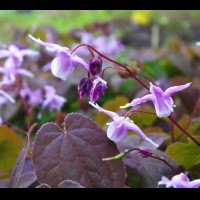






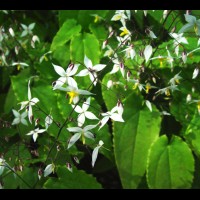
.jpg)





